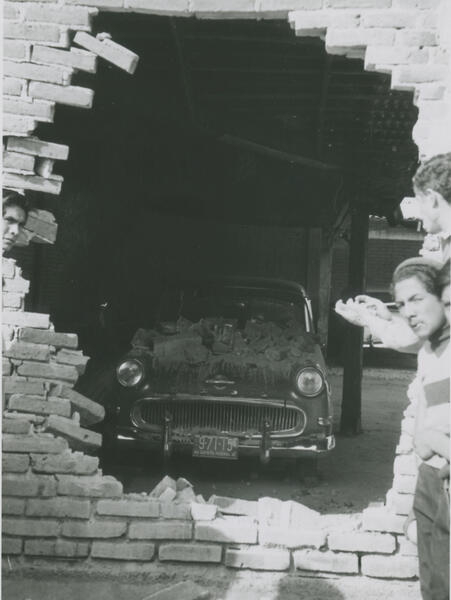Enrique Metinides in the Andy Warhol Museum
Maimed in Mexico: The Early Car Crash Photographs of Enrique Metinides, which is on display now through April 18 at the Andy Warhol Museum, shows the gaze of the curator Eric Shiner, who discovered the work of the Mexican photographer and found a similarity between his images and the “Car Crash” paintings from Andy Warhol.

Kurt Shaw, who wrote an article for Pittsburgh Tribune-Review about Metinides’ exhibition, interviewed Shiner, who told him: "Like Warhol, Metinides was completely absorbed by the underside of mainstream society -- the dark side, if you will… I thought it would be great to show contemporaneous photographs from Mexico to get people thinking about the similarities between our two nations 50 years ago."
As Shaw states, Shiner discovered the work of Metinides on Volta fair “that were in display in the both of the Josee Bienvenu Gallery, which he later visited to discover the photographer's full body of work -- all original prints dating mostly from the late 1940s to the early '70s”."I absolutely loved them for their power and elegance, and I thought they would look great in close proximity to Warhol's 'Car Crash' paintings," Shiner says to Shaw.
In his powerful article he states: “Featuring dozens of original black-and-white prints of horrific car crashes that occurred in Mexico city in the 1950s, '60s and '70s, as well as original paintings by Warhol of similar imagery, the exhibit offers an eyewitness account of human tragedy that is not easy on the eyes, or the stomach. For example, in "Accidente de automovil en llamas" (1971), a sedan is upside down and on fire; in "Automovil maveric accidentado" (1974), a Maverick is literally sheared in half, and in "Accidente" (1962), curious onlookers stare in awe at the hole in a wall caused by a car when it was gunned in reverse”.
In his article, Kurt Shaw remarks that “although Metinides never considered himself to be an artist, in recent years his work has enjoyed much critical acclaim thanks to his mastery of capturing emotion -- and even beauty -- in the stark face of fatality. Thus, in the style of noted American photographer Weegee (Arthur Fellig, 1899-1968), who took photographs of the aftermath of crime scenes in New York City, Metinides captured the dark side of life in Mexico City, and helped fuel readers' desire for gore and mayhem”. “Metinides' early black-and-white photographs -continues Shaw- are shown in proximity to several of Andy Warhol's Car Crash paintings from the early 1960s. Warhol collected crime scene photographs ranging from suicides to auto accidents, and turned many of those haunting images into silkscreen paintings, which today stand as some of his most powerful and sought-after work. Just like Metinides, Warhol examined the underbelly of society and the public's voracious appetite for gossip, whether about a celebrity, or in this case, death and disaster”.
The conclusion of Shaw regarding Metinides and his relation with Warhol’s work is remarkable: “Warhol's fascination with these images are evident with his compulsion to create the paintings. But Metinides' motivation -- as evidenced in his photographs -- is much more direct. He presents the high drama of humanity in as stark a way as possible. In this way, it causes one to question the work of both artist and photographer. Are they tapping into our natural sense of human curiosity? Of course. Like any car crash, you can't help giving this small exhibit a second look”.
In 2008, the Show Double Exposure: William Eggleston and Enrique Metinides, was reviewed for Leslie Cami for The New Yorker. The media states: “Metinides is the Weegee of Mexico—a tabloid news photographer drawn to small-scale catastrophes and the ordinary people involved in them. Most active from the nineteen-forties through the seventies, he had killer instincts and a great eye, both apparent in this group of small, vintage car-crash pictures. The photographs’ blunt, matter-of-fact quality makes them all the more surreal. One car sits intact just inside the ragged hole that it made in a brick wall, but most are smashed into instant sculptures. Injured passengers feature in only a few shots, but those are as riveting and awful as any of Warhol’s “Disasters.” Enrique Metinides was born in 1934 in Mexico City where he still lives. He stopped photographing professionally in 1993 when he left La Prensa. He now mostly stays home, cataloguing video footage of live accidents from television for a growing personal archive. He also collects objects, including more than 4000 model ambulances and police cars. His work was first brought to the attention of the art world in 2000 with his first solo exhibition at the Museo Universitario de Ciencias y Arte in Mexico D.F., followed by two London exhibitions: at the Royal College in 2002 and at the Photographer's gallery in 2003. Represented in Mexico by Kurimanzutto, Metinides' international recognition as an artist has continued to grow with his first US exhibitions at Blum and Poe in Los Angeles in 2006 and Anton Kern in New York last year, both received with critical acclaim.



